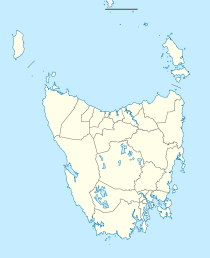Westerway, Tasmania facts for kids
Quick facts for kids WesterwayTasmania |
|||||||||||||||
|---|---|---|---|---|---|---|---|---|---|---|---|---|---|---|---|
| Population | 225 (2016 census) | ||||||||||||||
| Postcode(s) | 7140 | ||||||||||||||
| Location |
|
||||||||||||||
| LGA(s) | Central Highlands, Derwent Valley | ||||||||||||||
| Region | Central, South-east | ||||||||||||||
| State electorate(s) | Lyons | ||||||||||||||
| Federal Division(s) | Lyons | ||||||||||||||
|
|||||||||||||||
Westerway is a small country area in Tasmania, Australia. It is located about 29 kilometers (about 18 miles) northwest of the town of New Norfolk. In 2016, about 225 people lived in Westerway. It is part of two local government areas, which are like local councils: Central Highlands and Derwent Valley.
Contents
History of Westerway
Westerway was not always called by its current name. It was first known as Russell or Russelldale. This name came from a surgeon named J J Russell. He was part of a group who found some waterfalls near Fenton Forest. These are not the same as the famous Russell Falls we know today.
The Railway Arrives
The Derwent Valley Railway line reached the town in 1909. This was a big deal because trains could now connect Westerway to other places. The Russell Post Office opened a year later, in 1910.
Name Change to Westerway
In 1919, the town's name was changed to Westerway. This happened because people often confused "Russell" (the town) with "Russell Falls" (the waterfalls) which were further up the road. The new name, Westerway, was chosen by and named after W H Westerway. He was an important person in the town. He helped develop the area a lot. For example, he built a place for people to stay and a store. He also started a business that drove tourists to Russell Falls.
Community Buildings
Westerway School opened in 1920 with 36 students. For many years, the town had a bakery (from 1920 to 1960) and a police station (from 1947 to 1970).
The original Westerway Hall was very important during the 1934 bushfires. It was used as a temporary hospital to help people who were hurt. In 1939, it became a place where people could sign up to join the army. That first hall was later taken down and a new one was built in 1940. The hall that stands today replaced the 1940 hall after it burned down.
The Railway's Role
Westerway railway station was a key spot. It was the starting point for people traveling by pack horse to the Adamsfield osmiridium mine. Osmiridium is a rare metal. As the timber industry grew, more sawmills were built. The train line was then used to carry logs to places like Boyer and Hobart. For a while, tourists also used the Derwent Valley Railway to visit the area.
Westerway officially became a "locality" (a defined area) in 1959.
Geography of Westerway
The Tyenna River flows through Westerway. It enters the area from the west and flows out towards the east.
Roads in Westerway
A main road called Route B91, also known as Gordon River Road, goes through Westerway from east to west. Another road, Route C608 (Ellendale Road), starts where it meets B91 and goes northwest out of the area.


